|
Postcards
from:
Las Vegas Nevada
Algeciras Spain
Rabat Morocco
Madrid Spain
Yaounde Cameroon
Douala Cameroon
Addis
Ababa Ethiopia
Lalibela Ethiopia
Axum Ethiopia
Gondar Ethiopia
Bangkok Thailand
Las Vegas Nevada
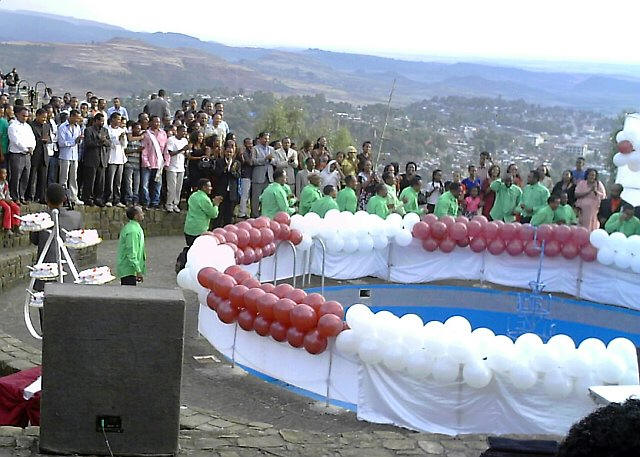
Gondar Ethiopia: A team of professional
photographers and videographers with bright
illumination lighting moved around among the guests
making a permanent record of the important event for
the bride and groom... and blinding the rest of us
whenever we became the subject of their recording
efforts. the rhythmic clapping never ceased. I never
caught a glimpse of the main characters in this
drama.
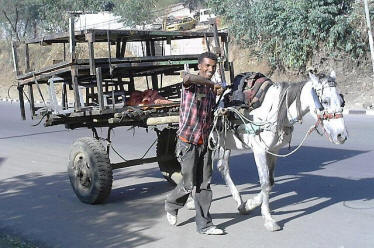
Gondar Ethiopia: One horse
power vehicles are very popular in Gondar. In fact,
they are popular all over Ethiopia. This guy seemed
to get a kick out of the fact I wanted to photograph
him. Ethiopians drop the initial "E" in pronouncing
the name of their country, making it just TIOPIA.
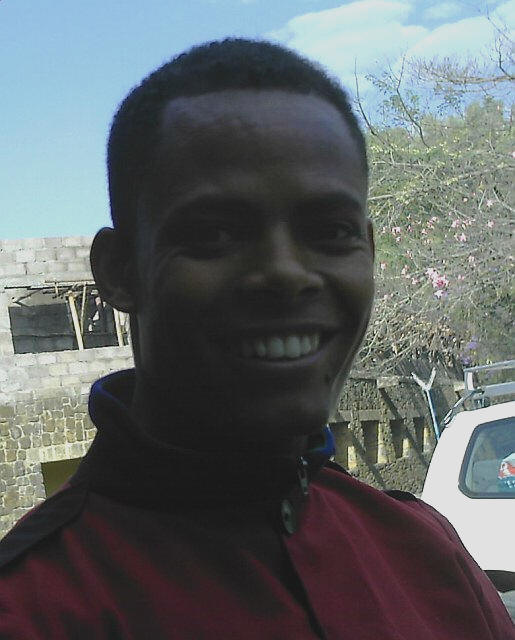
Gondar Ethiopia: Another of the very friendly and
helpful liveried bellmen I met at the hotel.
Electrical outlets in my room malfunctioned and he
got the assignment to make them work to my
satisfaction. They remained temperamental, but once
we had everything connected I just let everything
alone for the remainder of my stay.
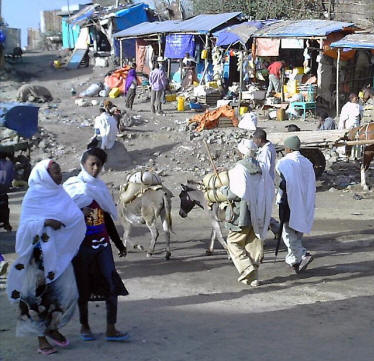
Gondar Ethiopia: One of the more or less permanent
market areas, this one at the bottom of the mountain
on which the Goha Hotel sits high above the city
center.
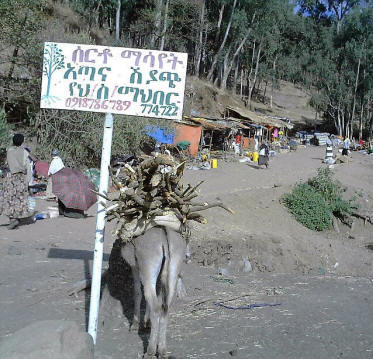
Gondar Ethiopia: As the paved road from the hotel
down the mountain reaches the edge of the city this
market area off a side road comes into view. The
donkey carries a load of firewood to be sold in the
market.
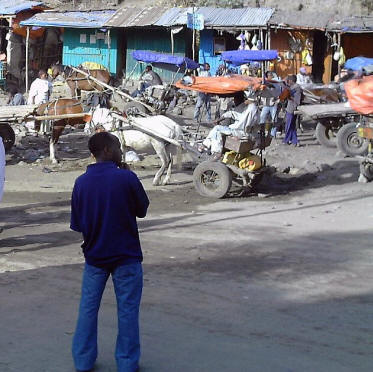
Gondar Ethiopia: Another shot of a more or less
permanent market area; this one at the bottom of the
mountain on which the Goha Hotel sits. Notice all
the horse drawn carts... or are they chariots?
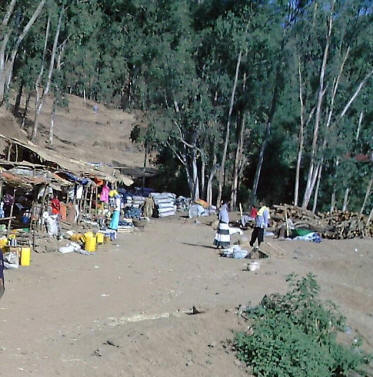
Gondar Ethiopia: As the paved road from the hotel
down the mountain reaches the edge of the city this
market area off a side road comes into view. Large
piles of firewood off to the right in the background
sit ready for sale. Fuel is a big priority here.
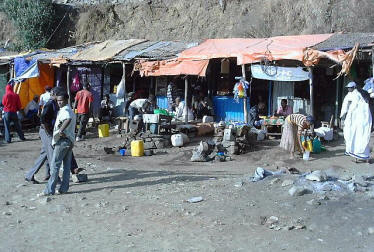
Gondar Ethiopia: As the paved road from the hotel
down the mountain reaches the edge of the city this
market area off a side road comes into view. Market
day is a day for socializing as well.

Gondar Ethiopia: As the paved road from the hotel
down the mountain reaches the edge of the city this
market area off a side road comes into view. This is
the parking lot for transportation used in an
Ethiopian market.
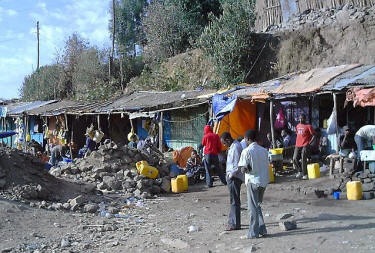
Gondar Ethiopia: Market
day is a day for socializing as well and groups of
men sit around drinking beer and gabbing.

Gondar Ethiopia: The road divides: to the left it goes up to the Goha Hotel
where I stayed; to the right it heads down into one of the residential
neighborhoods. This is a very busy intersection with traffic mostly
pedestrians and animals mingled with the occasional 4X4 vehicle.

Gondar Ethiopia: This is Adugna Akma, the driver-guide for my half day city
tour standing at the entrance to the Debre Birhan Selassie Church originally
built in the shape of a sailing ship.

Gondar Ethiopia: Adugna Akma, the driver-guide for my half day city tour
tries to entice me into the interior of the Debre Birhan Selassie Church
provided I first remove my shoes. Through his inquiry he discovers the
church is closed for cleaning and preparation for the special Epiphany
services in a few days.
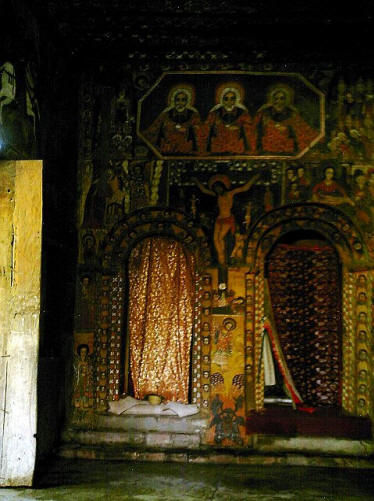
Gondar Ethiopia: Colorful paintings on the walls of the Debre Birhan
Selassie Church visited during a half day city tour.
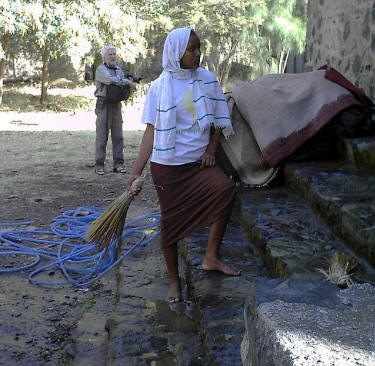
Gondar Ethiopia: Numerous people work to clean and spiff up the Debre Birhan
Selassie Church in preparation for the upcoming Epiphany observances.
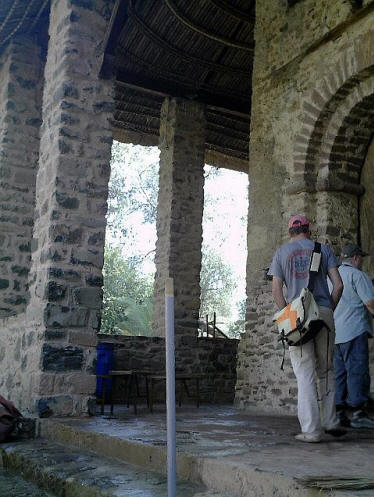
Gondar Ethiopia: Part of the covered walkway around the Debre Birhan
Selassie Church. Tourists may wander here without taking off their shoes.
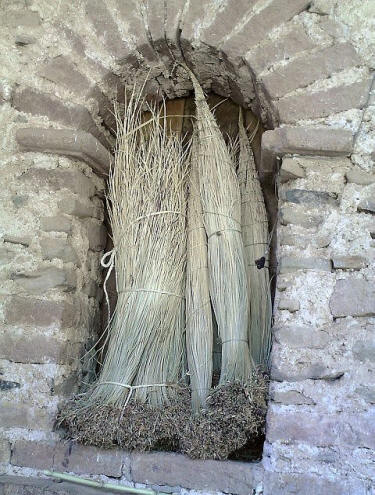
Gondar Ethiopia: Shuttered window alcoves service as storage shelves for
bales of grass at the Debre Birhan Selassie Church.

Gondar Ethiopia: High stone walls surround the Debre Birhan Selassie Church.
Tourists wander the quiet gardens snapping pictures at every turn.
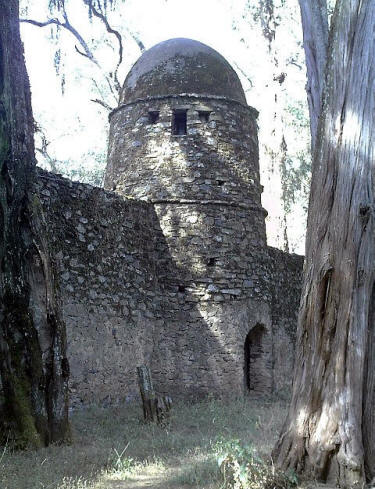
Gondar Ethiopia: High stone walls surround the Debre Birhan Selassie Church.
Tourists wander the quiet gardens snapping pictures as they go.
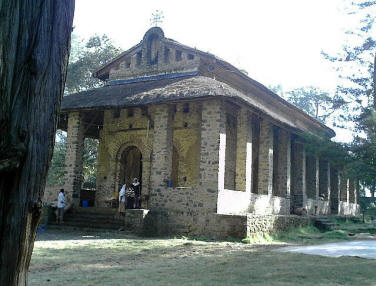
Gondar Ethiopia: This is the Debre Birhan Selassie Church. Guides say the
builders used a ship's design in planning it.
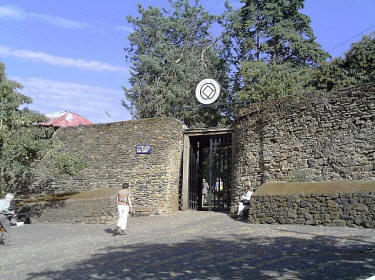
Gondar Ethiopia: Entrance to the Royal Enclosure where numerous castles are
located.
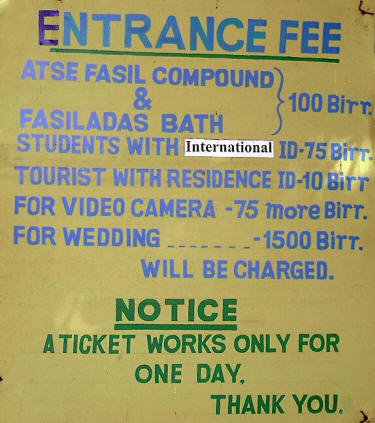
Gondar Ethiopia: Sign just inside the entrance to the Royal Enclosure where
numerous castles are located.
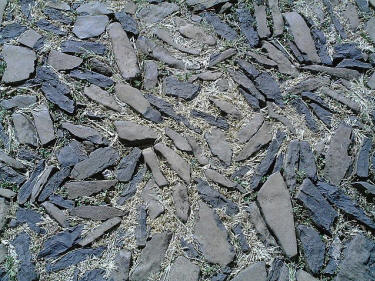
Gondar Ethiopia: Unusual flagstone walkway inside the Royal Enclosure where
numerous castles are located.
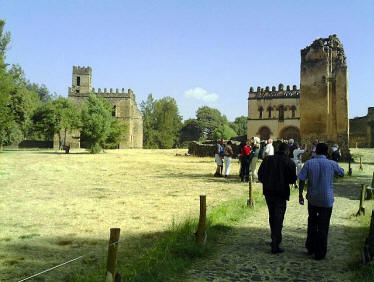
Gondar Ethiopia: Walking into the compound several castles are directly
ahead and a number of tour groups pause while their guides deliver short
lectures about each of them. I just look; "lectures" will come later as I
study information available on the Internet.
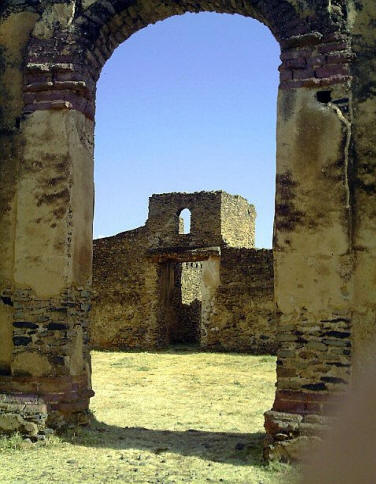
Gondar Ethiopia: Picturesque view of a castle gate seen through an old arch.
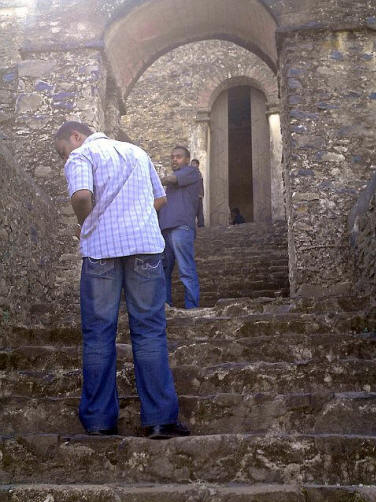
Gondar Ethiopia: A steep flight of stairs leads up to the entrance of one of
the principle castles in the compound.
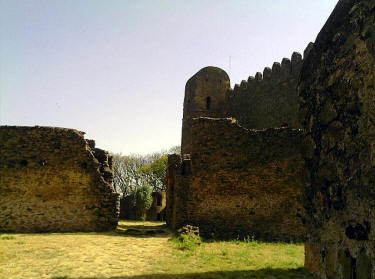
Gondar Ethiopia: More courtyards outside one of the castles. There are a lot
of separate castles in this compound; more like a walled city than a Royal
Compound.
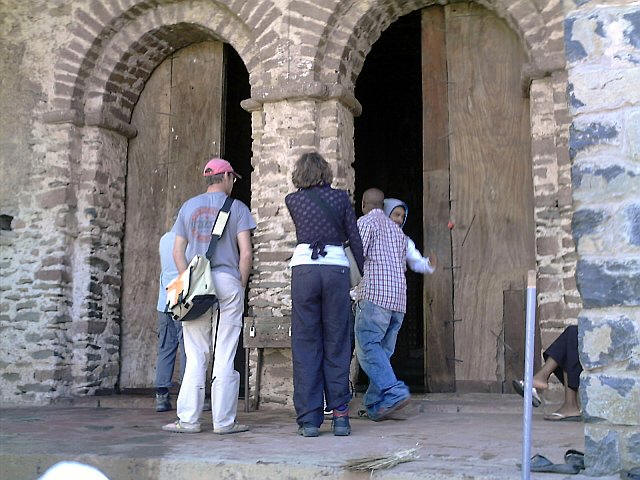
Gondar Ethiopia: Adugna Akma, the driver-guide for my
half day city tour tries to entice me into the interior of the Debre Birhan
Selassie Church provided I first remove my shoes. Through his inquiry he
discovers the church is closed for cleaning and preparation for the special
Epiphany services in a few days.
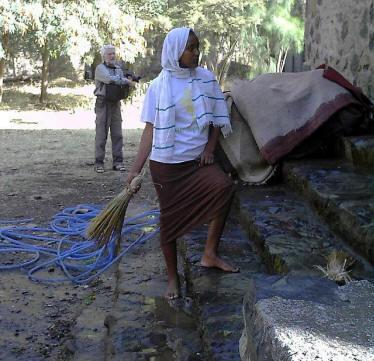
Gondar Ethiopia: Numerous people work to clean and
spiff up the Debre Birhan Selassie Church in preparation for the upcoming
Epiphany observances.
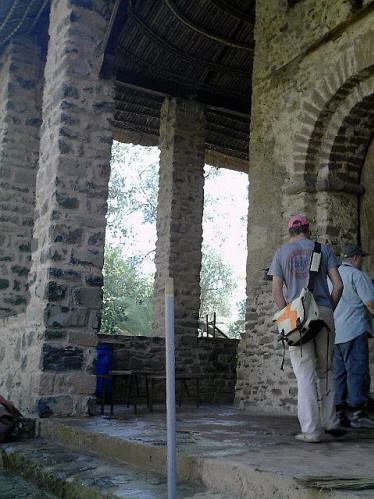
Gondar Ethiopia: Part of the covered walkway around the Debre Birhan
Selassie Church. Tourists may wander here without taking off their shoes.
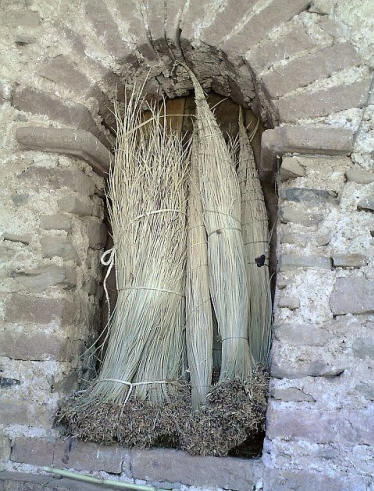
Gondar Ethiopia: Shuttered window alcoves service as storage shelves for
bales of grass at the Debre Birhan Selassie Church.
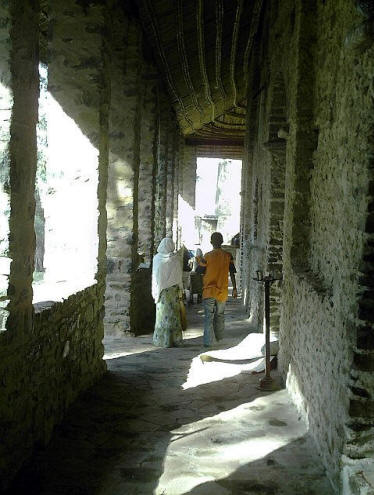
Gondar Ethiopia: Part of the covered walkway around the exterior of the
Debre Birhan Selassie Church. Tourists may wander here without taking off
their shoes.
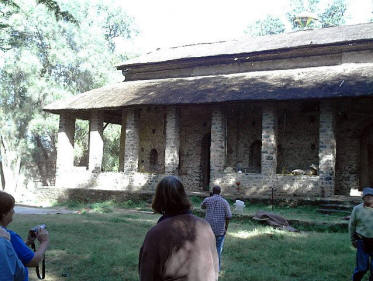
Gondar Ethiopia: High stone walls surround the Debre Birhan Selassie Church.
Tourists wander the quiet gardens snapping pictures at every turn.
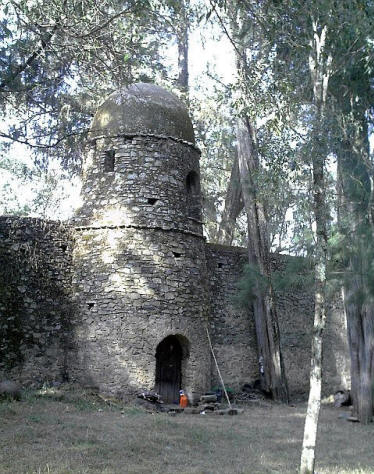
Gondar Ethiopia: High stone walls surround the Debre Birhan Selassie Church.
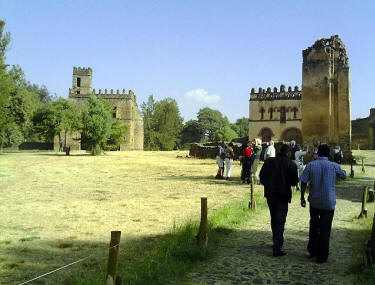
Gondar Ethiopia: Walking into the compound several castles are directly
ahead and a number of tour groups pause while their guides deliver short
lectures about each of them. I just look; "lectures" will come later as I
study information available on the Internet.

Gondar Ethiopia: Another view of one of the castles other ruins.
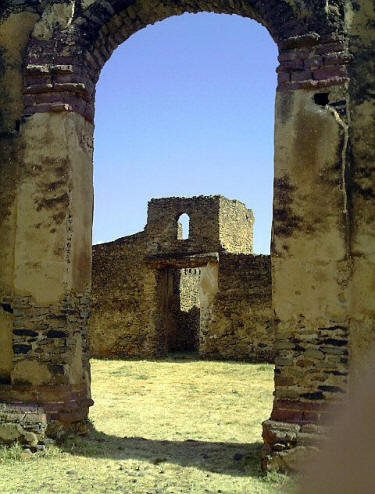
Gondar Ethiopia: Picturesque view of a castle gate seen through an old arch.

Gondar Ethiopia: More courtyards outside one of the castles. There are a lot
of separate castles in this compound; more like a walled city than a Royal
Compound.
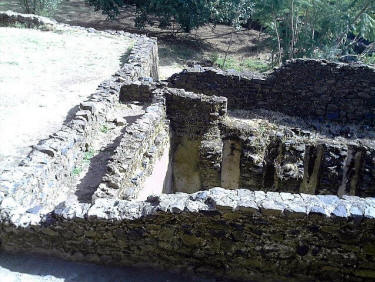
Gondar Ethiopia: Looking down from a different angle into what appears to be
a cistern from the upper story balcony in Adjam Seghed Ivasu's Castle
1682-1706.
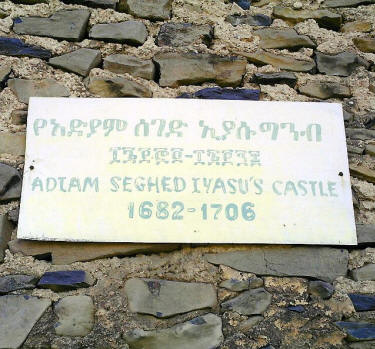
Gondar Ethiopia: Sign on Adjam Seghed Ivasu's Castle 1682-1706
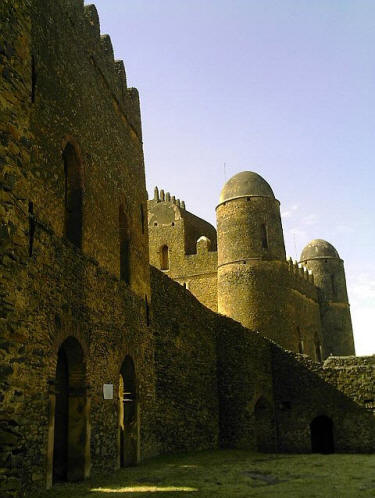
Gondar Ethiopia: Picturesque view of a castle compound. After a while, "when
you have seen one, you have seen them all..."
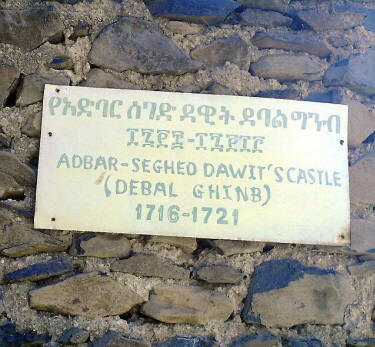
Gondar Ethiopia: Sign on Adbar-Seghed Dawit's Castle (Debal Ghinb) 1716-1721
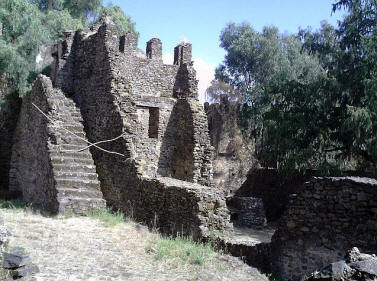
Gondar Ethiopia: More ruins found in the Royal Compound.
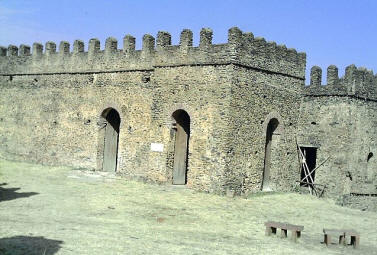
Gondar Ethiopia: I'm not sure why I took so many photographs of all these
buildings except to show the variety.
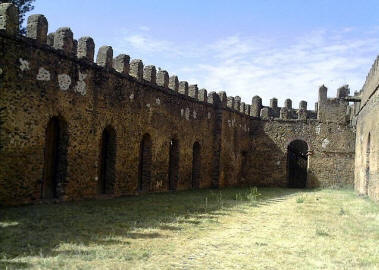
Gondar Ethiopia: This courtyard at the side of Messih-Seghed Bekaff's Castle
1721-1730 is pretty interesting. I have no idea of its use.
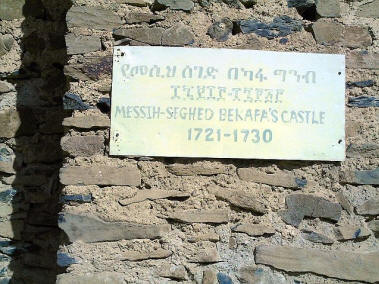
Gondar Ethiopia: Sign on Messih-Seghed Bekaff's Castle 1721-1730
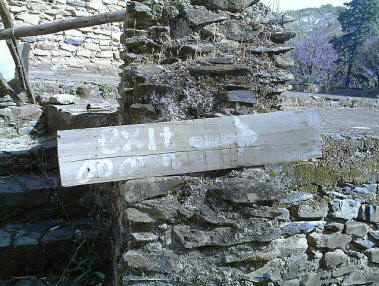
Gondar Ethiopia: This really obscure sign points the way to a well hidden
exit from the Royal Compound.

Gondar Ethiopia: This security grill covers one of the openings in the wall
around the Royal Compound off to the side of the well hidden exit.
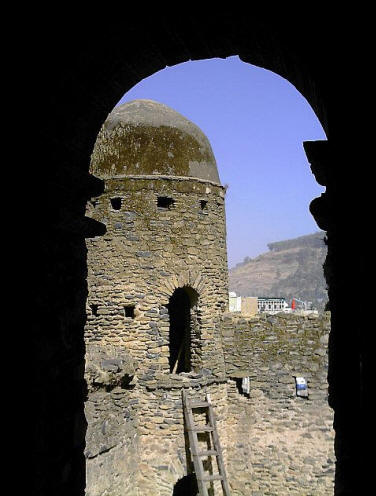
Gondar Ethiopia: Inside Birhan Seghed Kuregna Iyasu and Itegie Mintiwab's
Castle looking out. 1730-1755

Gondar Ethiopia: Fasiladas Bath is being filled for the annual festivities.
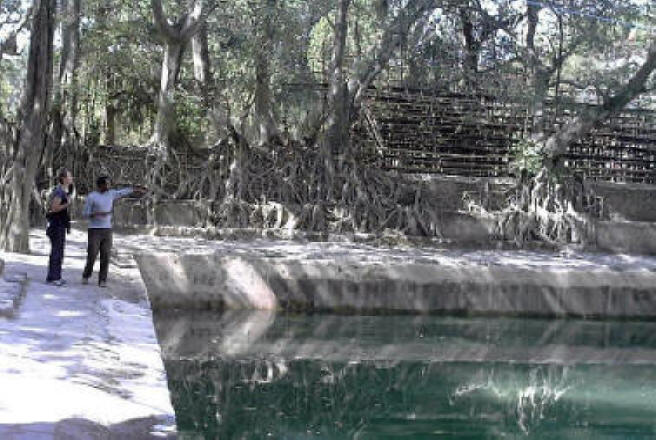
Gondar Ethiopia: Guide explaining the roots of trees
around the wall at Fasiladas Bath. They remind me of
similar growths seen at Angkor Wat in Cambodia. |
  15-22
January 2012 15-22
January 2012
Hello from Gondar Ethiopia,
Gondar is widely considered the premier tourist destination in Ethiopia. While there
are enumerable ruins attesting to its past glory, today it is just
another rambling and unplanned collection of urban sprawl surrounding islands of
historical monuments. The ruins of
castles and churches dating back
three hundred years or more speak of
better days when kings and epic battles defined the world
tolerated by human beings in those previous centuries. For the Ethiopians the
city is rich in
history; some glorious, some bitter. The city
stands as a
reminder of the years of occupation by the
Italians and the
lost territory which eventually became
Eretria
during their War of Independence.
One
horse power vehicles are very popular in Gondar. In fact, they are popular all
over Ethiopia. One guy seemed to get a kick out of the fact I wanted to take his
picture. I watched as several more similar carts filled with desks and cabinets all rolled by pulled by
donkeys. Apparently someone decided to change office locations. Donkey carts surely are the principle cargo transport vehicle used in
this part of Ethiopia... except for the backs of people. Nearly everybody
arrives on foot overloaded with cargo of some kind, often nothing
more than a huge bundle of firewood. It makes me wonder about the quality of
life ordinary people enjoy in this part of the world. Exercise itself is a good
thing, but hiking ten or fifteen kilometers carrying a fifteen kilogram rucksack
for the "fun" of it is a lot different from trudging twice that distance
carrying twenty or thirty kilograms into the city market in order to make enough
money to buy the bare necessities for your family's meals.
Curiously, Ethiopians
commonly drop the initial "E" in pronouncing the name of their
country, making it just Tiopia,
which for a while
confused me. While I have learned to speak almost no Amharic, I do catch a
recognizable word occasionally and "Tiopia" is one of them. Many people speak
English everywhere I go, so lack of
Amharic has not proven to be a problem, especially in the areas popular with
foreign tourists.
The road out of the city
center soon divides:
to the left it goes up to the Goha Hotel where I stayed; to the
right it heads down into one of the residential neighborhoods. This is a very
busy intersection on the main road out of town with traffic mostly pedestrians and animals mingled with the
occasional 4X4 vehicle. I found it hard to believe this could be the main
entrance to the best hotel in Gondar, but a short distance further on beyond the
picture the dirt became paved with the road making a tight hairpin turn to the
left and up the mountain. Climbing the gradual incline on foot proved
invigorating after the long taxi ride into the city from the airport and I
looked forward to checking out the mountain top hotel. Several cars and delivery
trucks passed me in both directions as I approached the hotel entry drive.
People, probably hotel staff members passed on their way down the dirt paths
lining the paved road, possibly on their way home after work.
While I usually like
to walk into a new city center, twenty-one kilometers from the airport meant I took a taxi this time. After climbing the mountain at the edge of the
northern boundary of the city I arrived at an oasis of civility in this
land of dust and clutter, the
Goha Hotel. My initial reaction suggested I might need to plan for
an extended recovery period from the sticker shock about to be visited
on this intrepid wanderer. The lobby spoke of five star elegance and the
staff behaved as if they were accustomed to greeting important, well
healed guests. With some trepidation I started my initial query ritual:
"Availability? Internet? Room rates?" Assured the hotel could
accommodate me and that it had WiFi in the lobby only I thought I had
misunderstood the receptionist’s quotation of room rates so I repeated
what I had heard for clarification: "that is one hundred and fifty nine
U.S. dollars per night?"
"Oh no. The room rate is fifty-nine dollars." replies the gentleman
behind the counter with a beaming smile. I almost never take a hotel
room without looking at it first, but here if the grounds and lobby were
any indication I could not imagine even a remote possibility of
disappointment. While hesitating momentarily, the receptionist asked if I'd like to see what they currently had available.
Simple,
but functional and elegant, my room reminds me of the modern efficiency of the
IBIS Hotels I have come to use as a yardstick for evaluating other hotels I
discover. Television consisted of BBS and CNN only; that gets stale pretty quick
as both endlessly repeat the days news stories until viewers turn off the sets.
The room
is similar in most respects to the standard room in an IBIS Hotel which I have
come to use as a yardstick for measuring other hotels: compact, modern with all
the necessary amenities, no frills, just excellent value. Most rooms in the
hotel have two twin beds; the hotel does have a few rooms with large beds, all
occupied at the moment. After checking in I enjoyed the hotel set menu
lunch with a Pepsi (90 Birr or about $6). Throughout the meal the sounds of
chirping birds entertained diners, but looking around I saw none. Later that
evening during dinner I spotted several with bright red breasts flitting
overhead among
the chandeliers.
The
cavernous dining room in the Goha Hotel with floor to ceiling window views of
the city serves as a convenient aviary for visiting wild birds. During my first
lunch I imagined the bird songs filling the quiet must be the hotel's idea of
ecologically pleasant sound effects. Nope. When I saw the first bird I started
looking for poop, but found none. No doubt dining room staff has been ordered to
be vigilant themselves lest some finicky guest is offended.
The hotel obviously caters to tour groups which filled the
dining room for lunch every day of my stay. I heard groups speaking, French,
German and English in addition to other languages unrecognizable. People in
these groups pretty much ignored everyone except other members of their group,
not totally unexpected. The down side of my mode of travel is that it reduces
the chances for casual socializing so enjoyable at mealtimes. For people in the
groups, evening meals became elegant occasions for rehashing the day’s
discoveries over a bottle of wine or enjoying the city views from the
observation platform at tables covered with beer bottles, most empty.
Seeing the world in comfort on a tight schedule attracts a different kind
traveler: sensible rather than foolhardy, gregarious rather than contemplative,
cautious rather than adventuresome, deliberate rather than serendipitous. Which
is better? Do aging and health play a role? Does prior experience have an
influence, current particulars? I have on occasion signed on for day tours
myself where a package offered more convenient transportation possibilities. In
every case the regimentation reminded me why I crave independent travel and
avoid the group tours like an Ebola plague!
After
a good first night's rest in the hotel and a sumptuous breakfast, the hotel arranged a private half day
tour of the city with one of the cab drivers with whom they work. The (600 Birr
or $36) tour provided a pretty good quick look at the city and its historical
attractions. In addition to the
Debre Birhan Selassie Church, we visited the
Fasilides Castle compound as well as the Fasilides Bath
where legend has it royalty bathed, the walls
overgrown today with tree roots shown in one of my photographs.
My driver/guide, Adugna Akma seemed to know people everywhere we went.
A principle tourist
attraction
in the city
is the Debre Birhan Selassie Church. Guides say the builders used a ship's
design in planning it. High stone walls surround the main buildings. Tourists
wander the quiet gardens snapping pictures as they go. A covered
walkway surrounding the exterior of the church allows tourists to amble here without
taking off their shoes as is required for any entry into the interior. While I
explored the compound numerous people busied themselves
spiffing up the church grounds and buildings in preparation for the Ethiopian
Easter celebrations tomorrow.
Timkat (Epiphany), a week earlier is a major holiday throughout Ethiopia and
draws huge crowds of tourists. Inquiries found all hotels fully booked causing
me to delay my planned earlier visit to the popular pilgrimage destinations.
However, the Atse Fasil Compound
is the main tourist attraction in Gondar. Walking into the compound several castles are directly
ahead and a number of tour groups pause while their guides deliver short
lectures about each of them. I just look; "lectures" will come later as I study
information available on the Internet. There are a lot of separate castles in
this compound; more like a walled city than a Royal Compound. In addition to
massive dwelling structures one of the kings also built a library and a small cluster of
cages designed to house wild lions. Trying to imagine living inside the compound
I decided life might well have been quite pleasant for the privileged few who
called this place home.
GREEDY: One of the devices
physicists are trained to employ in assessing the nature of any phenomenon are
the boundary conditions. Evaluate what happens when a variable is allowed to go
to zero and then infinity. The real behavior will certainly be somewhere between
these two extreme boundaries. When I attempt to apply that principle to our
national congress I run into a dilemma: assuming all of our representatives only
consider the best interests of the electorate at one extreme and then that they only
think about their personal best interests at the other, doesn't produce a
clearer picture of the real situation. What I need is a spy who has complete
access to our congressional representatives' actual shenanigans, not just those
activities they want us to see that make them look good. Well, we have our spy,
a 30 year veteran who decided to defect to our side and all of my worst
suspicions
have been confirmed!
Mike Lofgren retired on
June 17
2011 after 28 years as a Congressional staffer. He served 16 years as a
professional staff member on the Republican side of both the House and Senate
Budget Committees. Believable whistle blowers are rare in the business of
politics, but Lofgren became so disillusioned by the tactics used by politicians
he decided to go public with a full disclosure of everything he had learned and
the consequences of continuing our Nation's business as usual. In a shocking
exposé article entitled: "Goodbye
to All That: Reflections of a GOP Operative Who Left the Cult" he pulls
no punches! The title might suggest to some he will trash the Republican Party
only, but that is not what he does. Both parties are "rotten," but he does
observe the GOP is a little more rotten than the Democrats. His insider's
assessment of the fatally dysfunctional political process designed to protect
and enhance the financial interests of those who make it possible for anyone to
get elected these days confirms what I have long
suspected, but have been unable to prove: the invisible power-elite run the
world for their own exclusive benefit!
"But both parties are not rotten in quite the same way. The Democrats have their
share of machine politicians, careerists, corporate bagmen, egomaniacs and
kooks. Nothing, however, quite matches the modern GOP." Read the article and see
if you don't agree it has the ring of truth with a capital "T."
Running a Google
search on the name: "Mike Lofgren" produced more than 200,000 hits so this is no
"crack pot" brewing a tasteless broth! Thanks to Entera for bringing this article to my attention.
I recommend it to anyone still able to think for themselves; hardly the majority
anymore, sadly.
The
central area of Gondar is where the
Italian occupation colonialists built
their infrastructure. The buildings are easily identified by their uniformly
yellow color, not particularly elegant, just numerous and distinctive. In the city center area
engine powered vehicles outnumber those with donkey power, a situation that is
immediately reversed a few blocks from the central area. Most people walk,
usually carrying obviously heavy “cargo” on their backs, making it easy for me
to identify with them and compare their meanderings with my own. People with things to sell often lead
donkeys overloaded with the stuff: fire wood, vegetables, strings of plastic
shoes/flip-flops, home-made clothing, charcoal and an endless variety of other
locally produced products.
Socializing is a common pastime and it is not uncommon to see two passing
donkeys stop side by side while their owner pass the time of day like two
gossiping ladies over the backyard fence a generation ago in America. (View
Shutterfly album of 118 photos taken during my three day visit to Gondar)
After three nights
lounging around the hotel, struggling with the temperamental Internet connection
in uncomfortable lobby chairs, walking the shady pathways circling the hotel
knoll, I'd
had enough and hopped a plane back down to Addis Ababa. I'll spend a few more
days in Addis before heading back home
and completing another circumnavigation of our magnificent Earth, my third "round th' world" excursion
since 1986.
PS: On 17 January a bus operated by Sky Bus
Transport plunged down an 80 meter embankment into a
120 meters deep gorge. Of the 46 mostly foreign
tourists on board,
43 died. Interestingly, I had considered taking
the twelve hour bus ride from Addis Ababa to Gondar,
but using the more highly recommended Salem Bus
Company with newer buses for the trip. At the last
minute the cheap Ethiopian Airlines fares convinced
me to trade speed for what is usually a more
interesting, though slower way to explore foreign
countries. This is a reminder that bus travel can be
a risky proposition in Third World countries.
PPS:
14 January 2012
I can see it is time
to break the silence. I left Cameroon in West Africa after deciding all the
hassles were no longer worth the promise of exploring the over touted
attractions of Gabon... but more on that when I get the next proper postcard
done.
I reached Ethiopia a couple days before December 25th and discovered Christmas
for Ethiopian Orthodox Catholics is celebrated on 7 January. So, I experienced
two Christmas celebrations this time around with a New Years sandwiched in
between.
On 6
January the huge goat population here is cut in half as every Ethiopian feasts
on goat meat Christmas Day. I happened to be walking through the animal market
on the 6th and watched as thousands of goats selected their dinner partners and
then the next day watched as they donated their no longer needed hides to huge
piles of pelts collected by tannery trucks near my hotel.
I have since moved on to the historical and archeological attractions in the
north of the country. It has all been interesting enough for several
"postcards," if I ever find a place where the Internet is reliable enough for
some serious writing.
I'll finish this prescript to the Addis Ababa postcard and look for a place to
take a nap after the big lunch just finished... accompanied by a half bottle of
wine here in a delightful mountain top hotel in Gondar with all its castles and
ancient church ruins.
FB
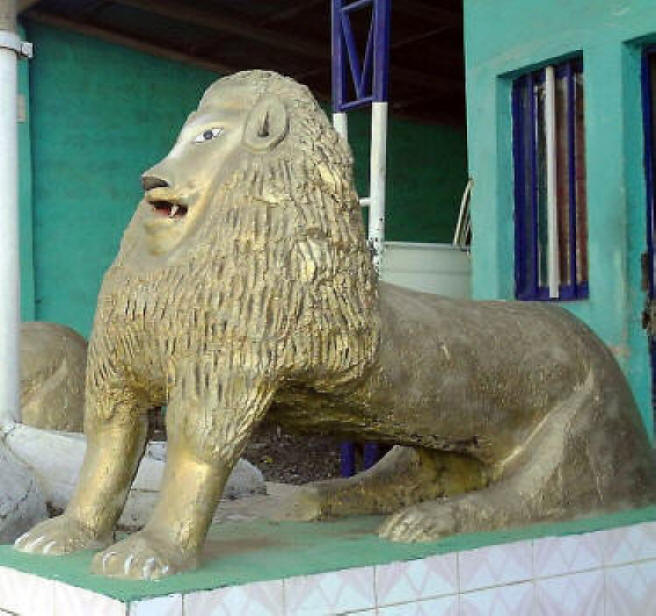
Gondar Ethiopia: Closeup of one of the members of
this odd pair of stylized lions caught my attention
as I saw something similar down in Addis Ababa.
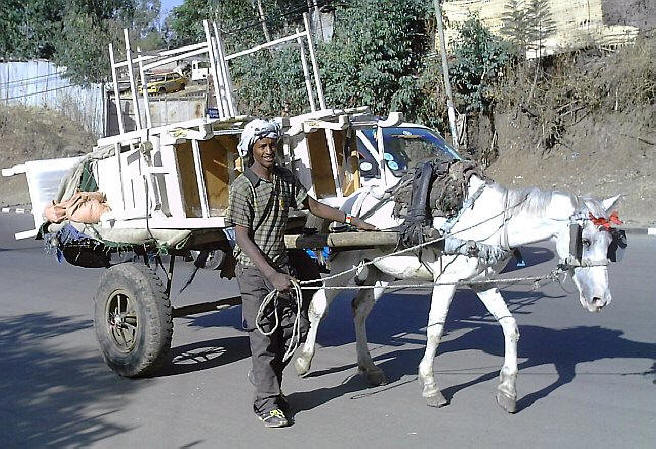
Gondar Ethiopia: Must be an office moving as here
comes a second load of desks. One horse power
vehicles are very popular in Gondar. In fact, they
are popular all over Ethiopia. This guy smiled when
he spotted my camera.
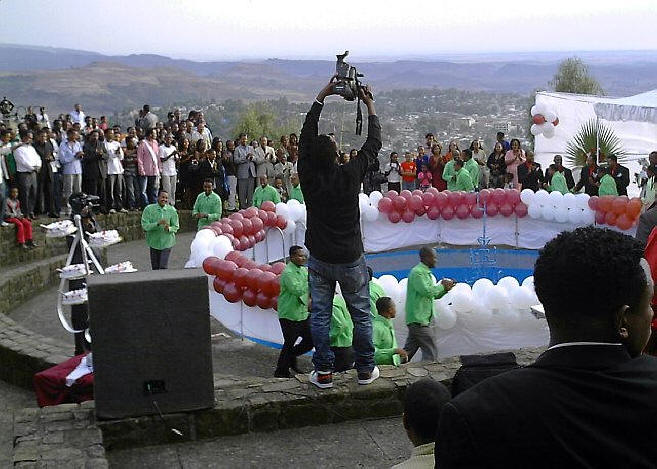
Gondar Ethiopia: A team of professional
photographers and videographers with bright
illumination lighting moved around among the guests
making a permanent record of the important event for
the bride and groom... and blinding the rest of us
whenever we became the subject of their recording
efforts. the rhythmic clapping never ceased. I
never caught a glimpse of the main characters in
this drama.
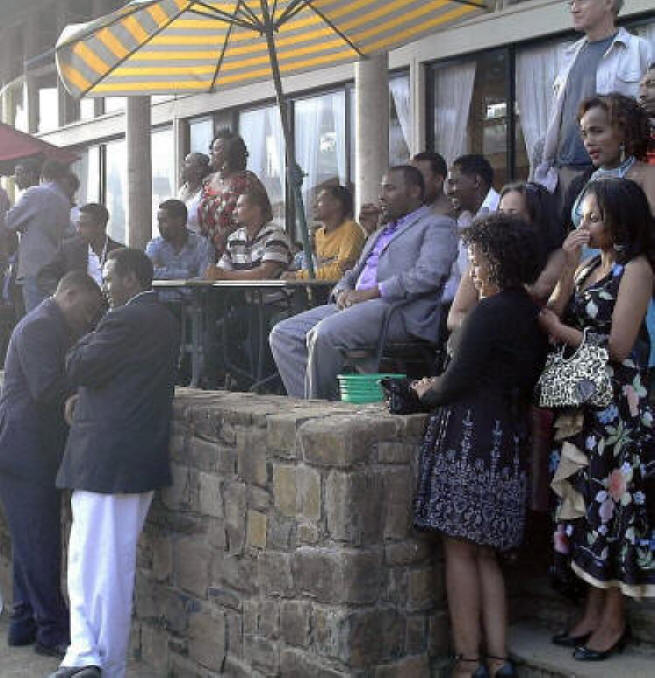
Gondar Ethiopia: Part of the large crowd of guests
attending the Saturday wedding held at the Goha
Hotel where I stayed for three nights in the city.
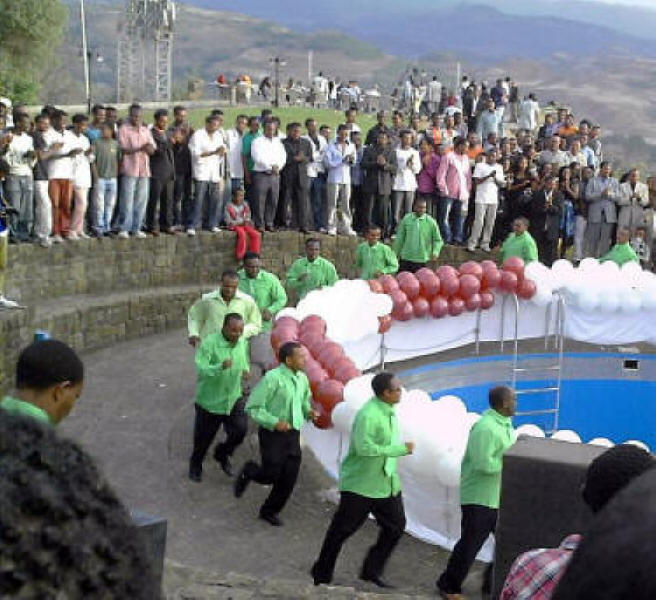
Gondar Ethiopia: Part of the large crowd of guests
attending the Saturday wedding held at the Goha
Hotel where I stayed for three nights in the city.
the green shirts kept up their running/dancing and
chanting for an intolerably long time while the
crowd of guests egged them on with rhythmic
clapping.
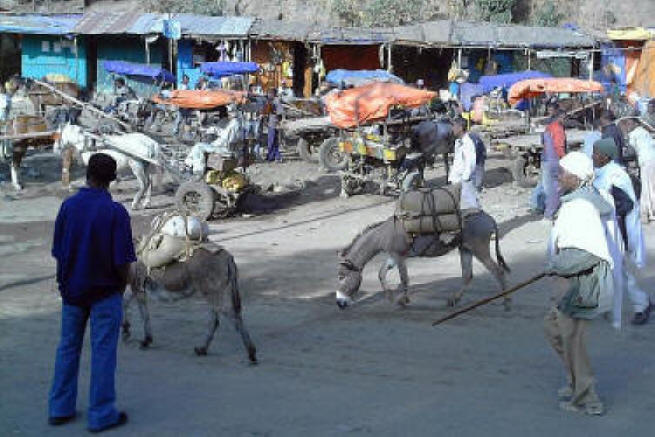
Gondar Ethiopia: Seen in this market area are people
and their animals and their vehicles. Notice the guy
to the right foreground with his staff or walking
stick. Most guys carry them and use them to adjust
the weight of heavy objects carried on their
backs... or as an arm rest at other times.
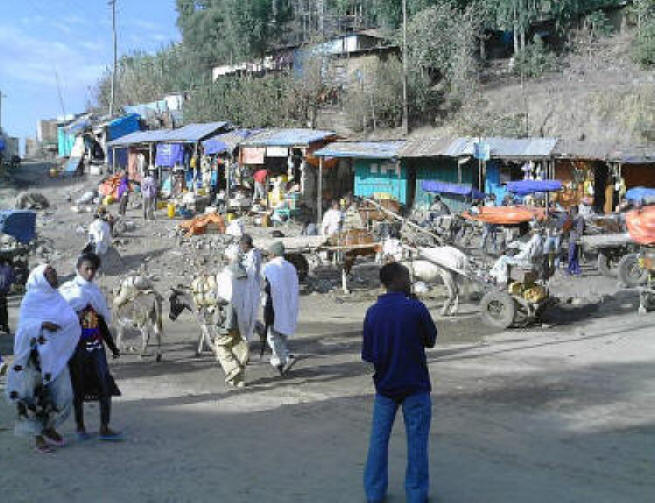
Gondar Ethiopia: Market day is a very busy time for
both sellers and buyers.
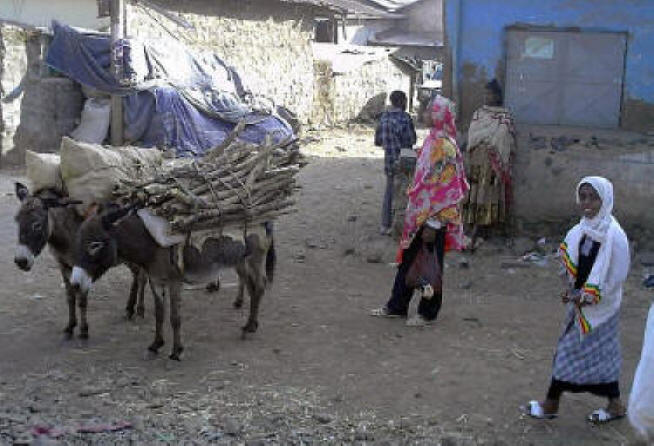
Gondar Ethiopia: Donkeys loaded with things to sell
and a cheerfully dressed young girl smiling at the
funny looking foreigner with the tiny black thingy
up to his eye.
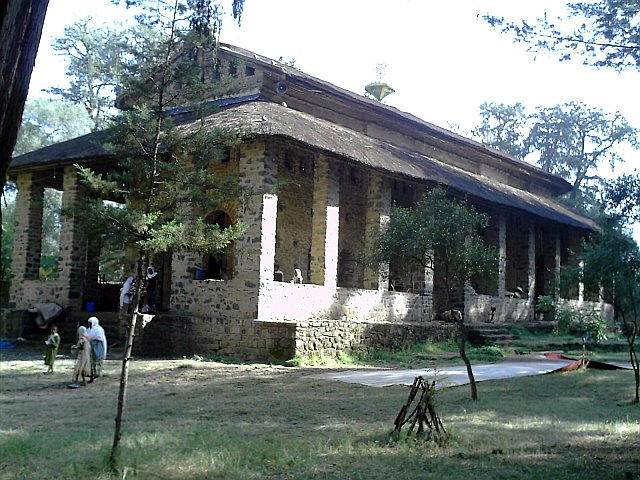
Gondar Ethiopia: This is the Debre Birhan Selassie
Church. Guides say the builders used a ship's design
in planning it.
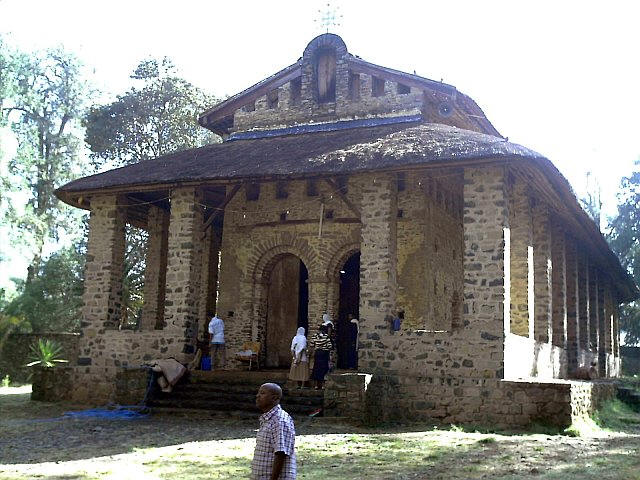
Gondar Ethiopia: This is the Debre Birhan Selassie
Church. Guides say the builders used a ship's design
in planning it.
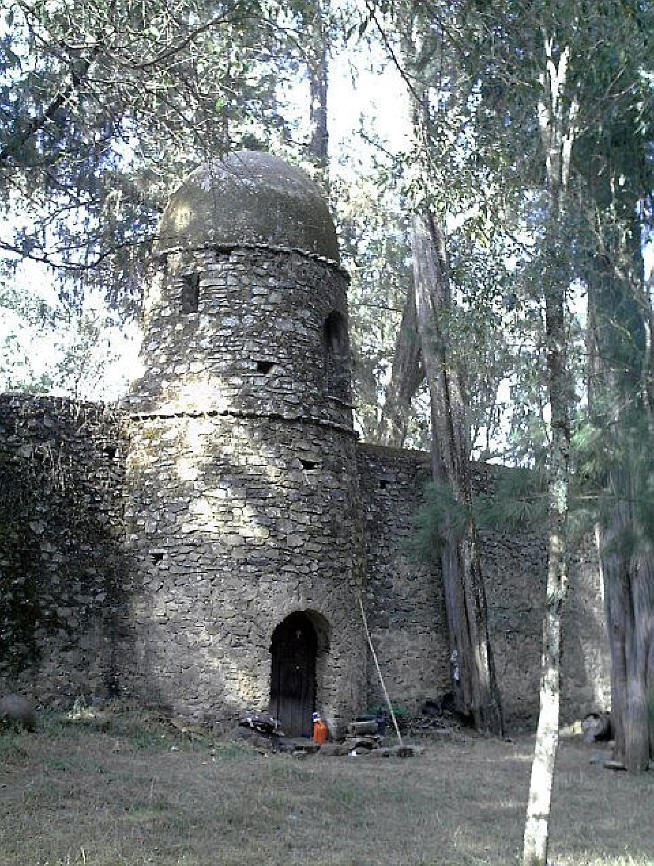
Gondar Ethiopia: High stone
walls surround the Debre Birhan Selassie Church.
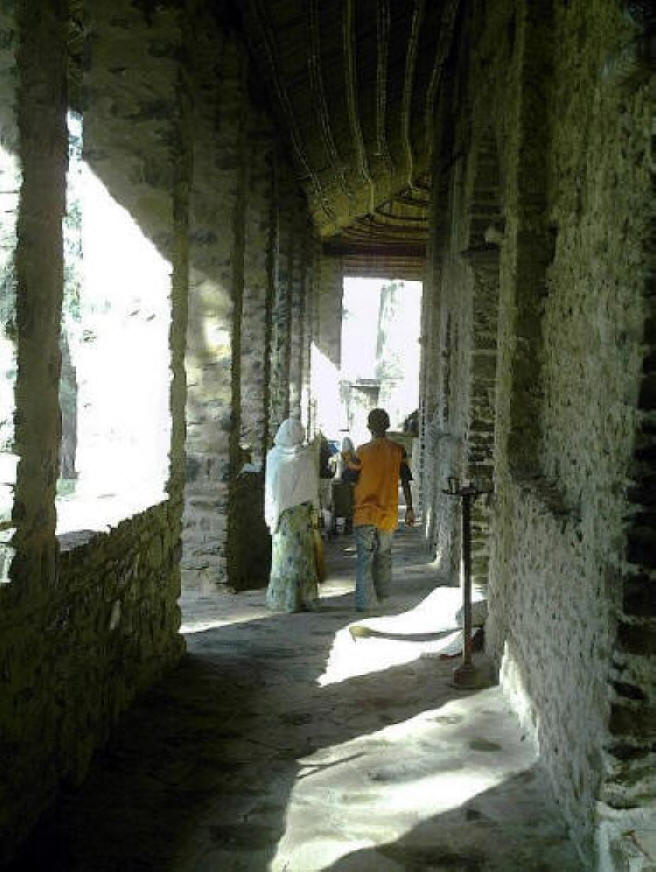
Gondar Ethiopia: Part of the covered walkway around
the exterior of the Debre Birhan Selassie Church.
Tourists may wander here without taking off their
shoes.
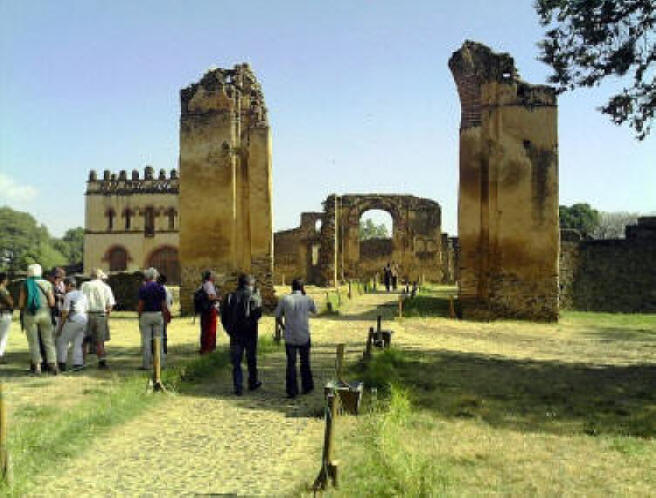
Gondar Ethiopia: Walking into the compound the main
path goes through what appears to be the ruins of a
city gate with several castles directly ahead and a
number of tour groups milling about.
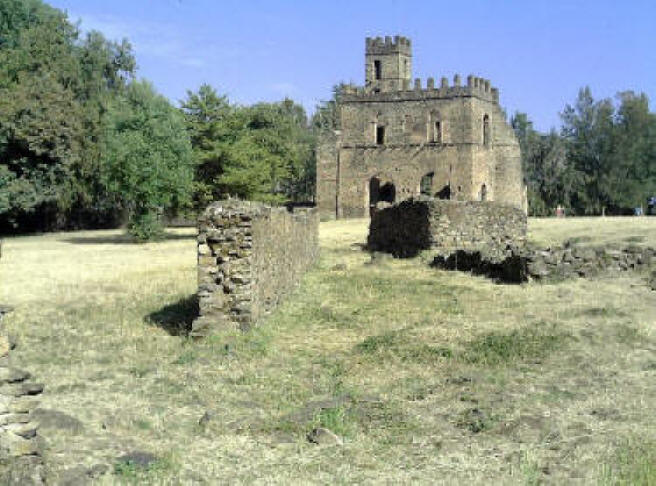
Gondar Ethiopia: Another view of one of the castles
other ruins.
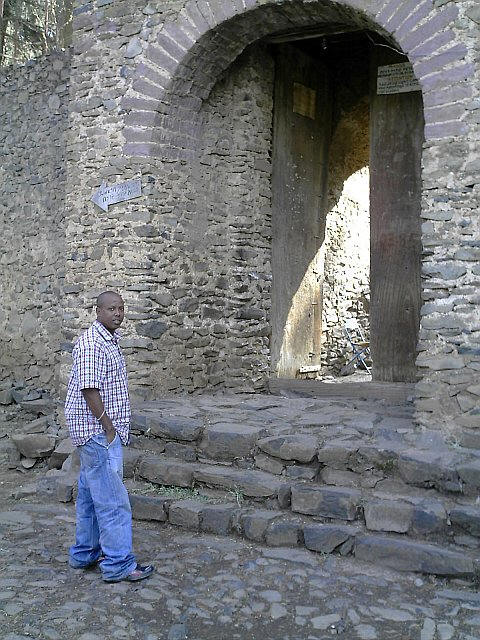
Gondar Ethiopia: This is Adugna
Akma, the driver-guide for my half day city tour
standing at the entrance to the Debre Birhan
Selassie Church originally built in the shape of a
sailing ship.
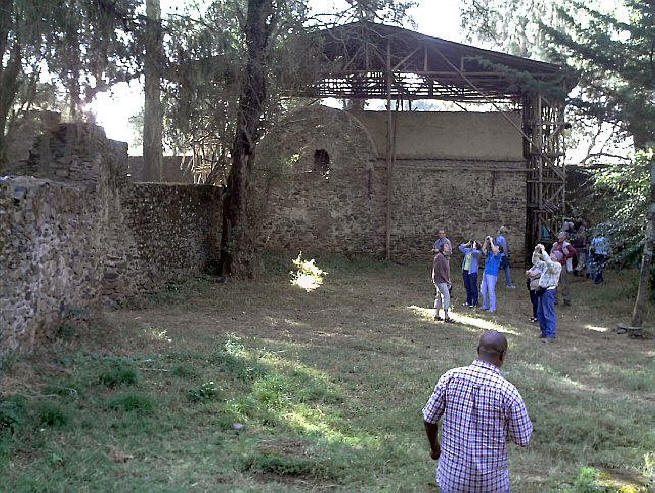
Gondar Ethiopia: High stone walls surround the Debre
Birhan Selassie Church. Tourists wander the quiet
gardens snapping pictures at every turn.
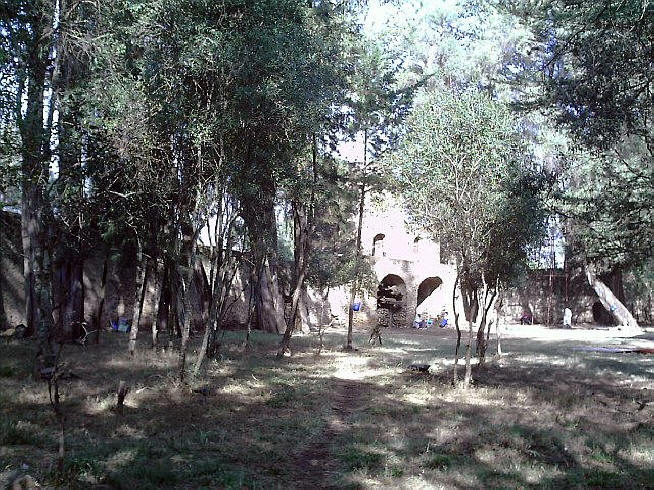
Gondar Ethiopia: High stone walls surround the Debre
Birhan Selassie Church. Tourists wander the quiet
gardens snapping pictures at every turn.
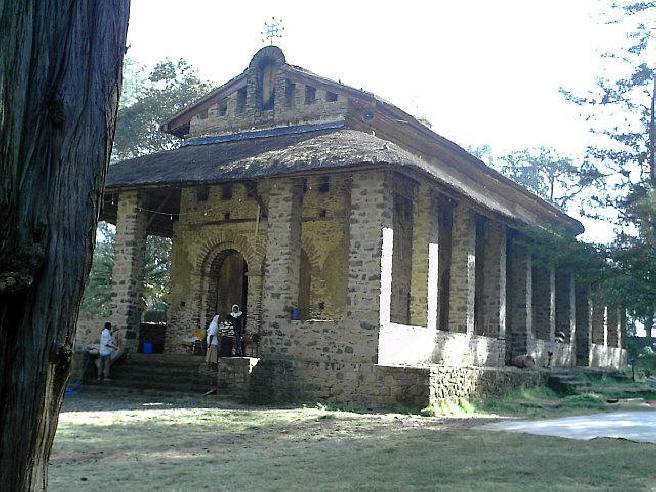
Gondar Ethiopia: This is the Debre Birhan Selassie
Church. Guides say the builders used a ship's design
in planning it.

Gondar Ethiopia: Entrance to the Royal Enclosure
where numerous castles are located.
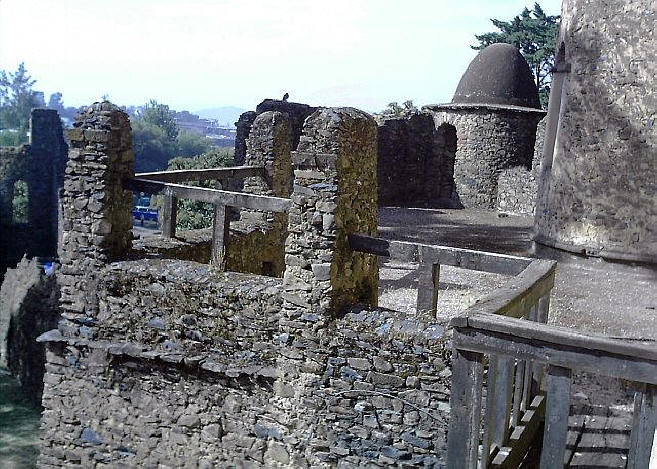
Gondar Ethiopia: Upper story balcony in one of the
castles. From this vantage point I could look down
into what appeared to be a cistern.

Gondar Ethiopia: Another view of the upper story
balcony in one of the castles.
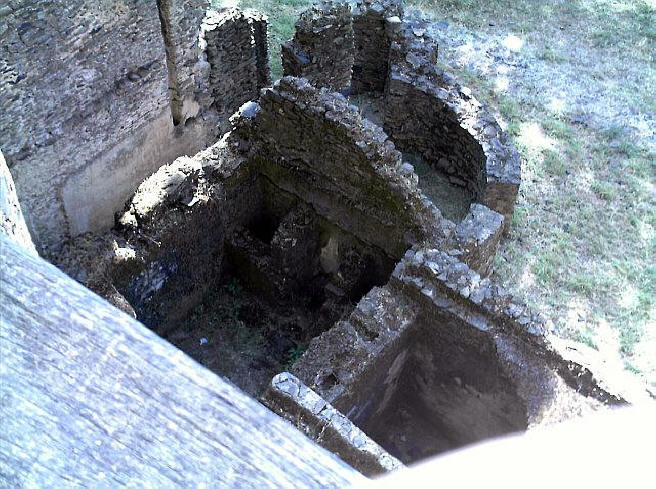
Gondar Ethiopia: Looking down into what appeared to
be a cistern from the upper story balcony in one of
the castles.
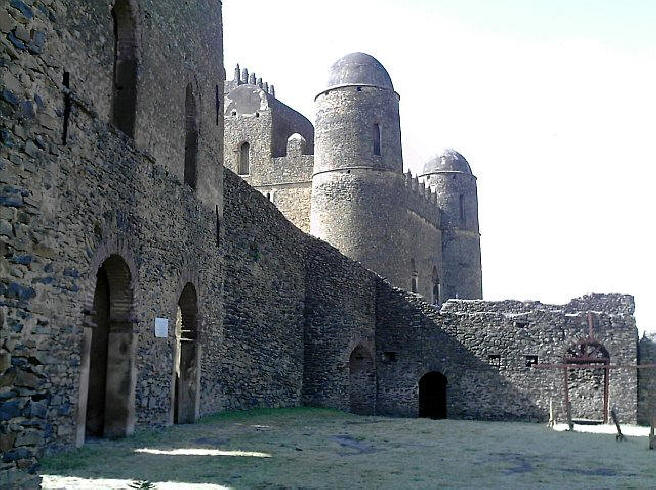
Gondar Ethiopia: More castles seen in the extensive
compound.
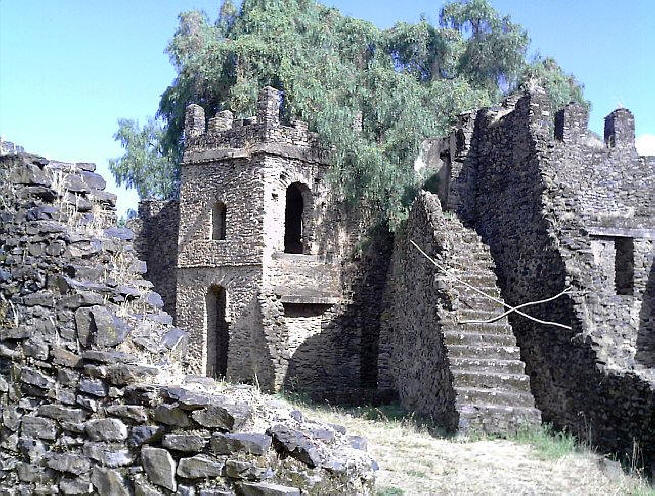
Gondar Ethiopia: And yet another castle.
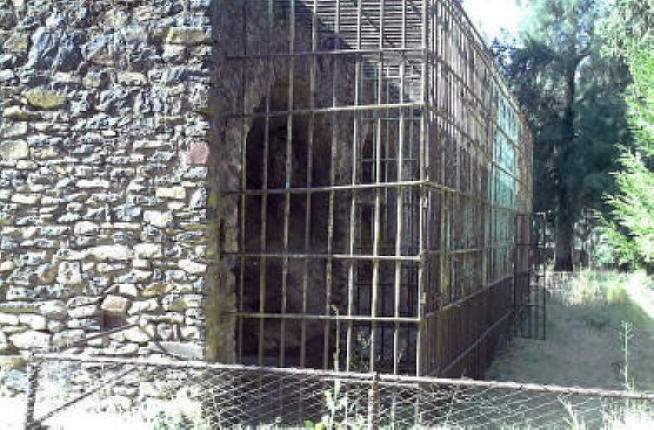
Gondar Ethiopia: These are the cages in which the
king's personal collection of lions were kept.
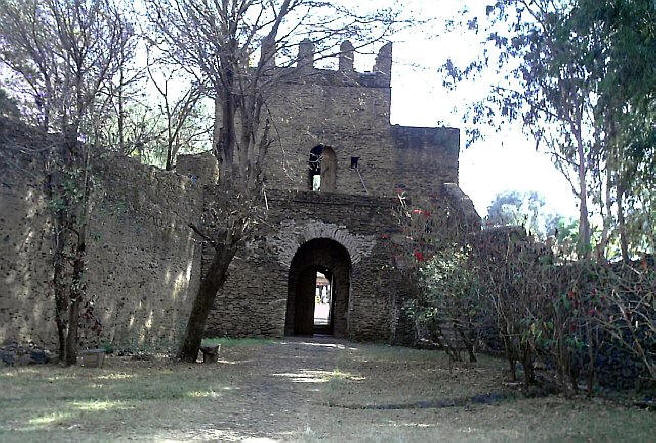
Gondar Ethiopia: A really obscure sign points the
way to this well hidden exit from the Royal
Compound.
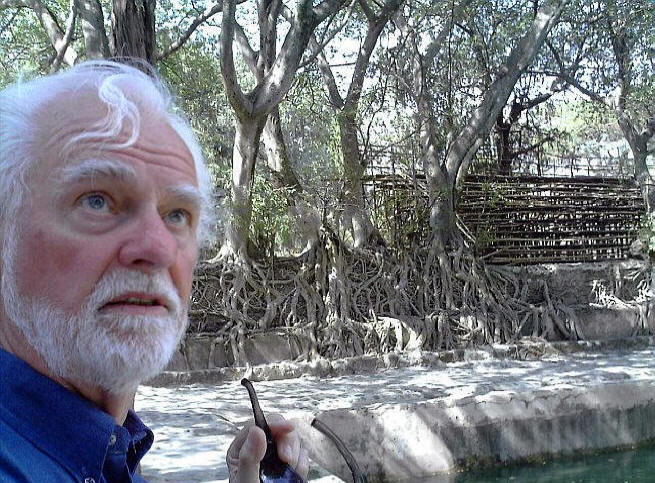
Gondar Ethiopia: Author pondering the roots of trees around the wall at
Fasiladas Bath. They remind me of similar growths seen at Angkor Wat in
Cambodia.
|
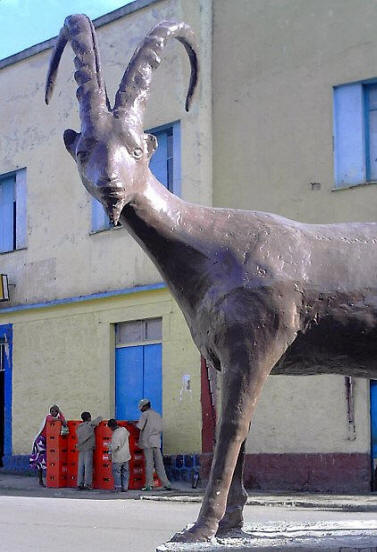
Gondar Ethiopia: This odd sculpture with the human
like face is worthy of a photograph, but it is not
the reason I took the picture. Notice the kids in
the lower left background hovering around the beer
bottle cases. The bottles will all soon be empty
because the kids are collecting any beer remaining
in the emptied bottles and filling a larger plastic
bottle... to drink themselves or maybe sell??
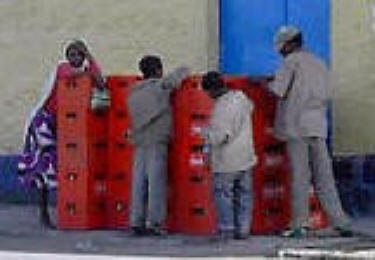
Gondar Ethiopia: Close-up of the kids hovering
around the beer bottle cases. They are collecting
anything left in the bottles to be recycled. One can
only speculate on what they are up to.
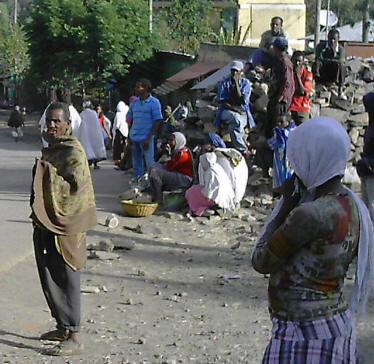
Gondar Ethiopia: More market day activity. The guy
to the left is a beggar who has just attempted to
help me become a donor to his personal cause. There
were many others in this area.
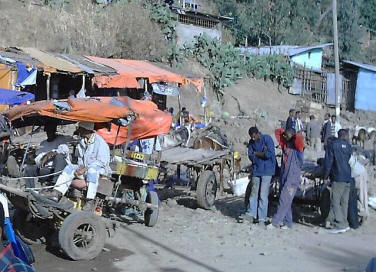
Gondar Ethiopia: In the market areas lots of guys
just stand around loafing. Some of the donkey carts
are apparently waiting for someone to hire them to
haul cargo.
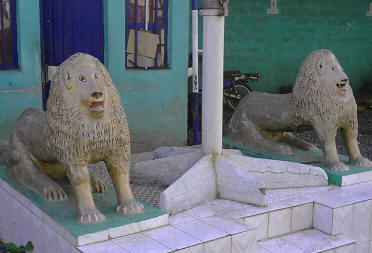
Gondar Ethiopia: This odd pair of stylized lions
caught my attention as I saw something similar down
in Addis Ababa.
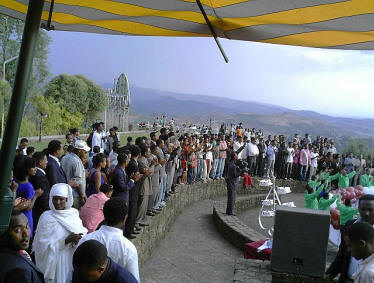
Gondar Ethiopia: More of the large crowd of guests
attending the Saturday wedding held at the Goha
Hotel where I stayed for three nights in the city.
Notice the guys in green shirts in the lower right
hand corner of the photo. They are chanting a
traditional wedding message unique to the village
from which the bride comes. For village weddings
they would be circling the bride's hut.

Gondar Ethiopia: A team of
professional photographers and videographers with
bright illumination lighting moved around among the
guests making a permanent record of the important
event for the bride and groom... and blinding the
rest of us whenever we became the subject of their
recording efforts. the rhythmic clapping never
ceased.
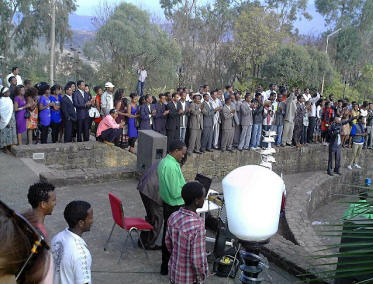
Gondar Ethiopia: Part of the large crowd of guests
attending the Saturday wedding held at the Goha
Hotel where I stayed for three nights while in the
city.The professional sound equipment filled the air
with the monotonous chanting traditional for this
particular tribal group. To my sophisticated ears it
all sounded rather primitive even though business
suits and party dresses dominated.
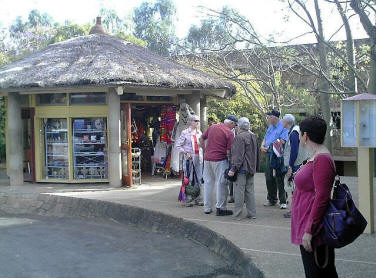
Gondar Ethiopia: One of the many tour groups arriving at the hotel and
discussing the contents of the gift shop in the background... or some other
equally inane subject.
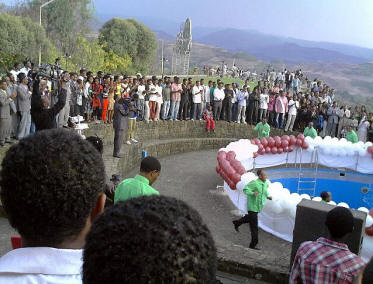
Gondar Ethiopia: Part of the large crowd of guests
attending the Saturday wedding held at the Goha
Hotel where I stayed for three nights in the city.
the green shirts kept up their running/dancing and
chanting for an intolerably long time while the
crowd of guests egged them on with rhythmic
clapping.
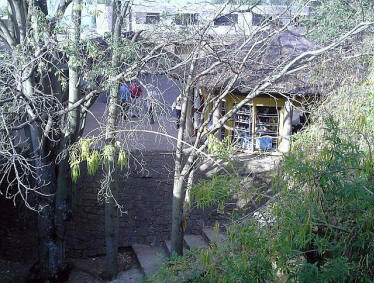
Gondar Ethiopia: View of the little gift shop in front of the hotel entrance
drive as seen from the third floor balcony that runs along the front of
guest room entry doors. The hotel sits on a knoll so the second floor guest
rooms are at lobby level.
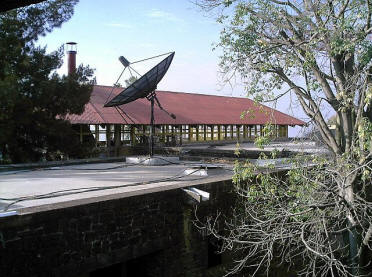
Gondar Ethiopia: The structure in the foreground is the lobby and hotel
offices; the taller structure behind it is the atrium like dining room that
served as an aviary the first two days of my stay. Wild birds had invaded
the interior and flew around among the hanging chandeliers until they were
chased out in time for the Saturday night wedding to be held there.
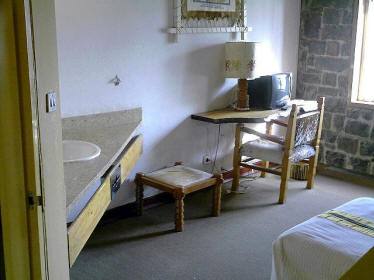
Gondar Ethiopia: Simple, but functional and elegant, my room reminds me of
the modern efficiency of the IBIS Hotels I have come to use as a yardstick
for evaluating other hotels I discover. Television consisted of BBS and CNN
only; that gets stale pretty quick as both endlessly repeat the days news
stories until viewers turn off the sets.
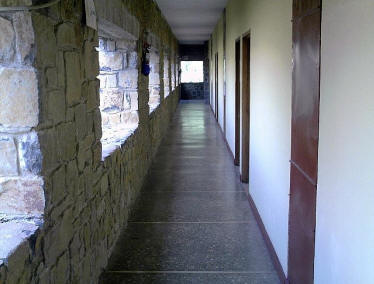
Gondar Ethiopia: This is the entryway balcony that runs along the third
floor of the guest room wing where my room is located. The openings in the
wall look down on the hotel's front entryway drive.
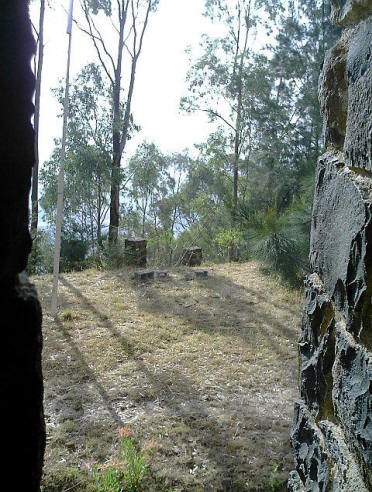
Gondar Ethiopia: The three stories of the guest room wing are reached by a
spiral staircase in a turret like structure at one end. These tall window
openings look out on the hotel's landscaped grounds and down to the city
below. The feeling is that of being in an ancient castle... completely in
keeping with the principle attraction of this city.
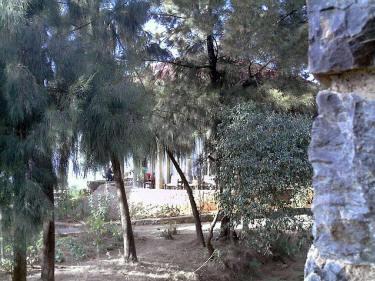
Gondar Ethiopia: Another view through tall window openings look out on the
hotel's dining room patio seating.
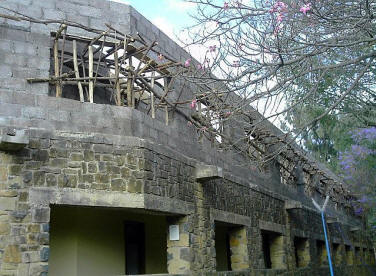
Gondar Ethiopia: This is an already large hotel, but expansion construction
is in progress as seen in this photo.
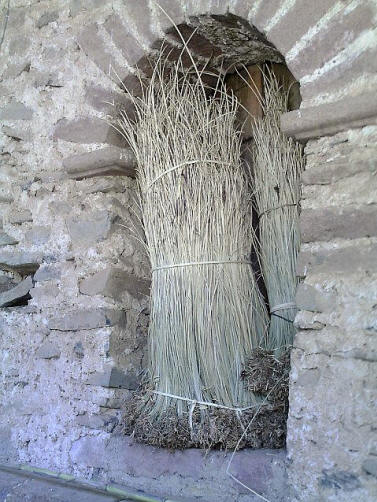
Gondar Ethiopia: Shuttered window alcoves service as storage shelves for
bales of grass at the Debre Birhan Selassie Church.
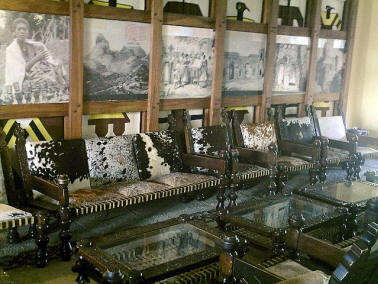
Gondar Ethiopia: Rustic lobby furniture frequently served as an Internet
Cafe as the WiFi signal could be counted on here. Tour groups coming or
going often filled all available seats with their overweight butts and the
air with their fatuous babbling. You might think I have developed a deep
prejudice against these camera toting, Bermuda shorted, baseball capped
international gadflies; but struggling
tolerance is a better characterization.
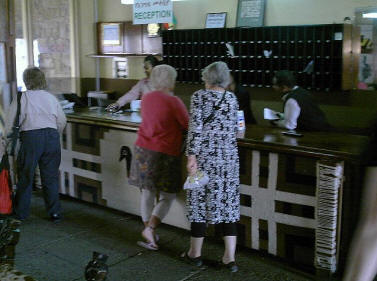
Gondar Ethiopia: Goha Hotel reception desk where I learned a number of
interesting facts about the city. A private half day city tour arranged by
the hotel provided a brief snapshot of the main tourist attractions of
Gondar. The female staff member explained some of the mysterious rituals
associated with Ethiopian weddings and the village to village variations to
be expected.
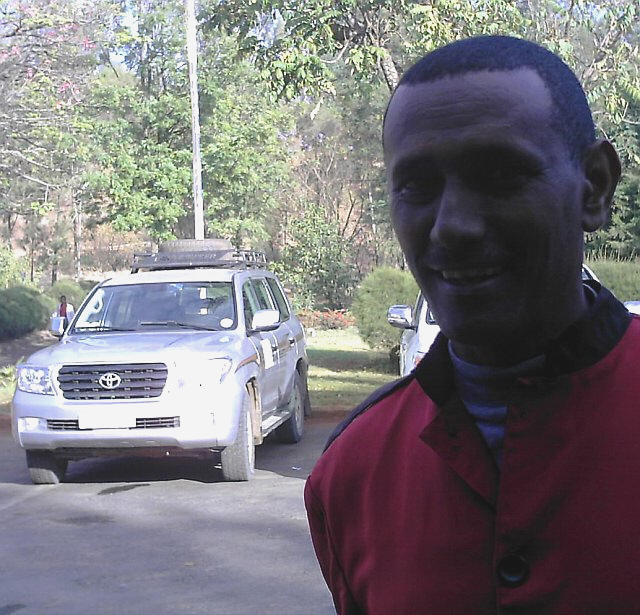
Gondar Ethiopia: One of the very friendly and
helpful liveried bellmen I met at the hotel. Because
I could understand his English we chatted
occasionally about Ethiopian customs... especially
the wedding rituals being played out two nights of
my stay in the hotel.
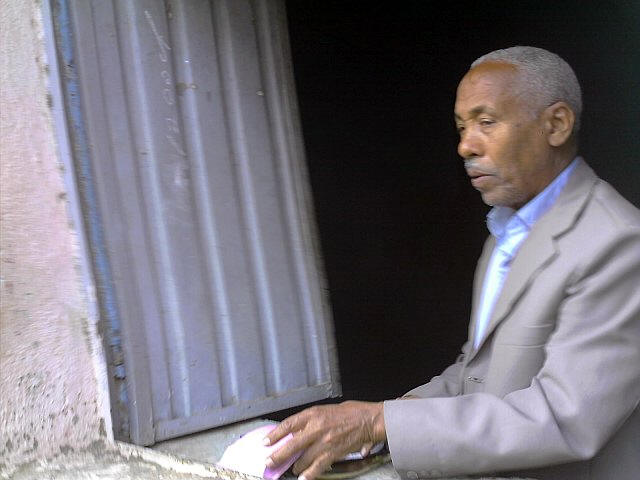
Gondar Ethiopia: Another of the front office hotel
staff members explaining building expansion plans
for the hotel. A third story is currently under
construction over the existing western wing.
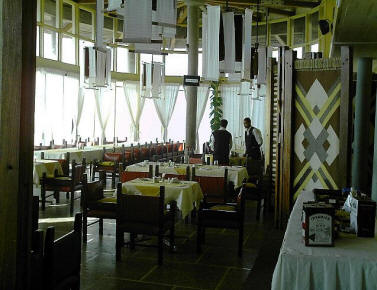
Gondar Ethiopia: Cavernous dining room in the Goha Hotel with floor to
ceiling window views of the city. The high ceilings served as a convenient
aviary for visiting wild birds the first two days in the hotel. During my
first lunch I imagined the bird songs filling the quiet must be the hotel's
idea of ecologically pleasant sound effects. Nope. When I saw the first bird
I started looking for poop.

Gondar Ethiopia: The high ceilings of the hotel dining room served as a
convenient stopping place for visiting wild birds. When I finally saw one of
them foraging for crumbs on the floor I wondered if any of them ever
relieved themselves over the tables. Search as I might, I never saw a single
piece of evidence of bird poop. This flock must have been toilet trained by
the staff, or...
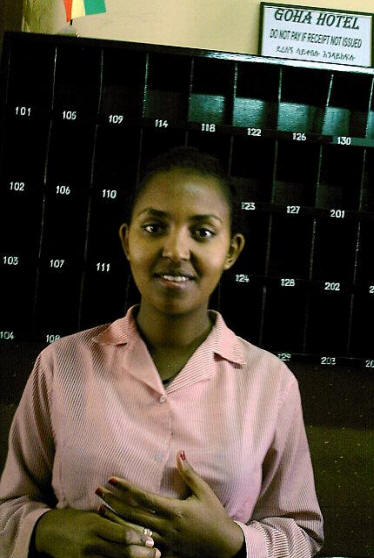
Gondar Ethiopia: Friendly, helpful reception desk staff member at the Goha
Hotel served as my local informant and arranged a convenient half day city
tour ($36). She must have been recently married as I now notice she is
fondling her wedding ring in this photo.
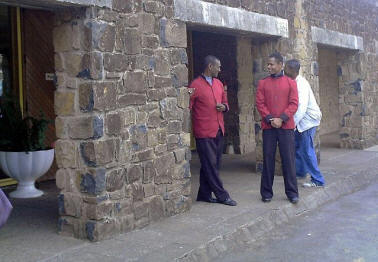
Gondar Ethiopia: Two of the bellmen with whom I had several interesting
conversations in their spiffy uniforms waiting for the next tour-bus to
disgorge its passengers.
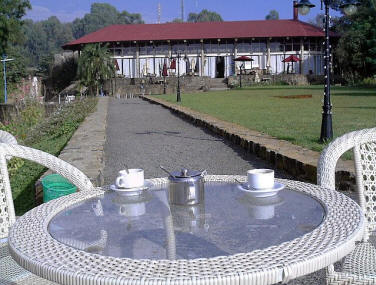
Gondar Ethiopia: This pleasant sitting/dining area sits at the vary edge of
the hotel property overlooking the city below. A steady flow of coffee, tea
and beer kept guests occupied as they enjoyed the incomparable views of the
city below. As long walks would mean climbing down and then back up the
mountain, I often made brief circuits around the hotel grounds ending here
at the observation area.
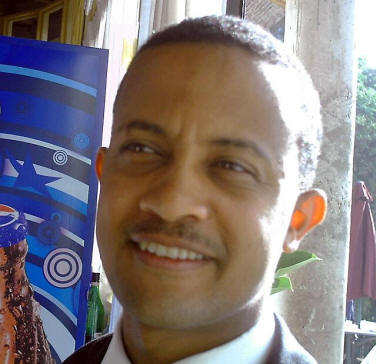
Gondar Ethiopia: Front office staff member at the Goha Hotel assisted me
with finding a comfortable place to work with a good WiFi signal and
comfortable place to park my body... I actually never did find such a place,
but tolerated discomfort for short periods as I tried to work.
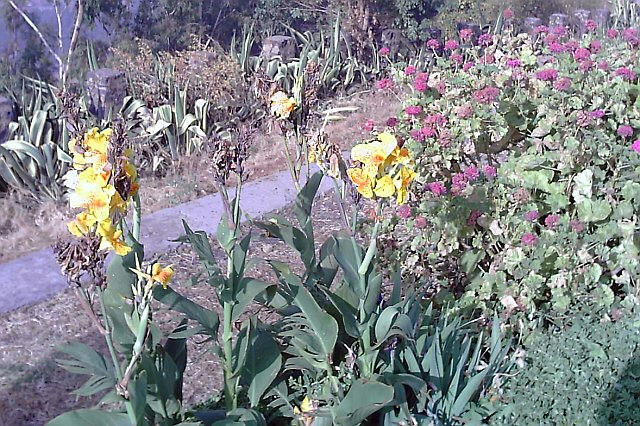
Gondar Ethiopia: Landscaping around the hotel
grounds is a combination of flowers and natural
vegetation.
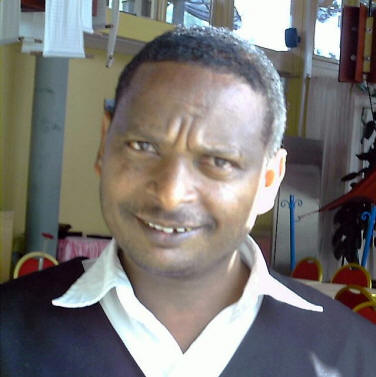
Gondar Ethiopia: Friendly, helpful reception desk staff member at the Goha
Hotel served as another of my local informants, but puzzled over my
questions of walking distances to the airport; it is more than twenty
kilometers and I planned to walk it.
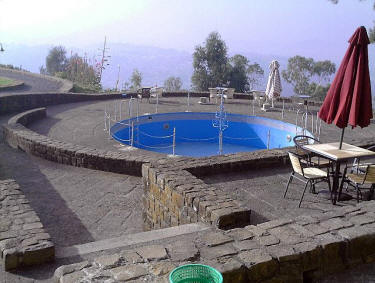
Gondar Ethiopia: Empty swimming pool at the Goha Hotel served as a center
piece for the two weddings held there during my stay. Staff told me it has
been dry for years.
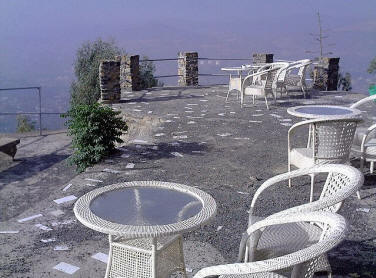
Gondar Ethiopia: A better view of the observation platform at the Goha
Hotel. While guests frequently wandered out to the overlook, rarely did all
the seats fill up. Small groups came and went, sometimes sitting with a beer
for a while before moving on.

Gondar Ethiopia: This is Adugna Akma, the
driver-guide for my half day city tour standing at
the entrance to the Debre Birhan Selassie Church
originally built in the shape of a sailing ship.

Gondar Ethiopia: Stone walls surround the Debre Birhan Selassie Church.
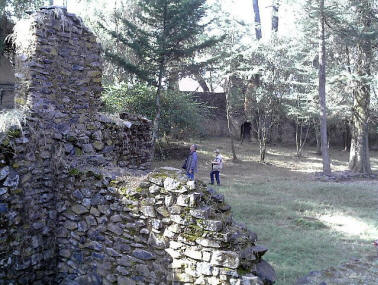
Gondar Ethiopia: Stone walls surround the Debre Birhan Selassie Church.
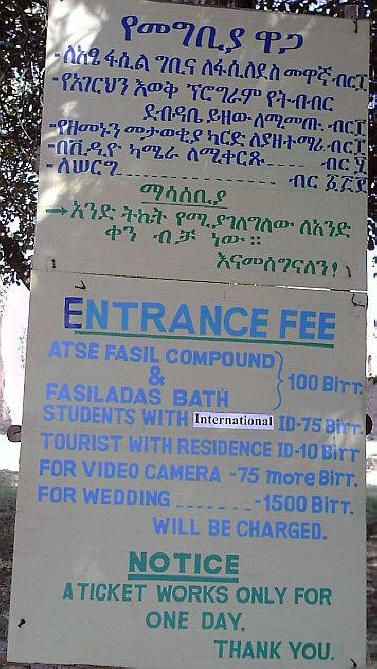
Gondar Ethiopia: Sign just inside the entrance to the Royal Enclosure where
numerous castles are located.
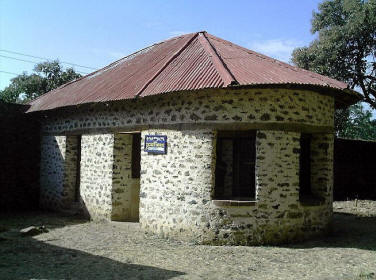
Gondar Ethiopia: Ticket office just inside the
entrance to the Royal Enclosure where numerous
castles are located. Entrance fee for the compound
is 100 Birr or about $6.
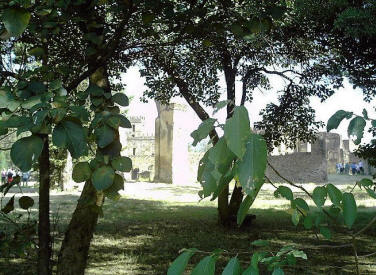
Gondar Ethiopia: View of the first castle as seen
just inside the entrance to the Royal Enclosure
where numerous castles are located.
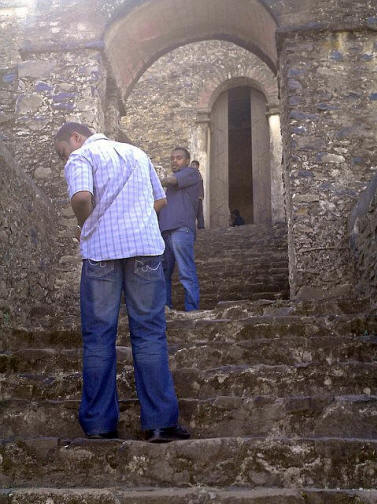
Gondar Ethiopia: A steep flight of stairs leads up to the entrance of one of
the principle castles in the compound.
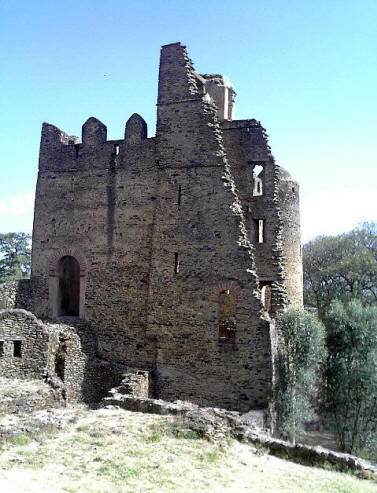
Gondar Ethiopia: Another castle in poor repair, but they all are hundreds of
years old.

Gondar Ethiopia: ... and yet another castle wall.
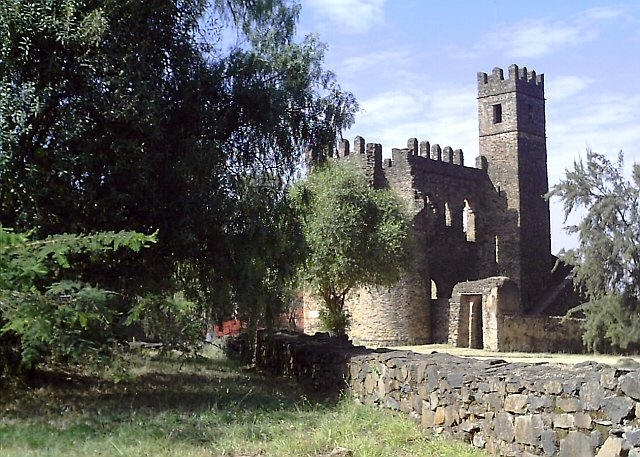
Gondar Ethiopia: Yep. It's another castle, probably very important a few
hundred years ago. Now it is just a big pile of stones with empty cavities
inside.

Gondar Ethiopia: King Fasil's Archive 1632-1667. This guy had a love affair
with books and had this library built to house his personal collection.
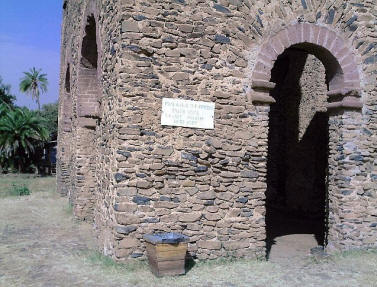
Gondar Ethiopia: King Fasil's Archive 1632-1667. This guy had a love affair
with books and had this library built to house his personal collection.
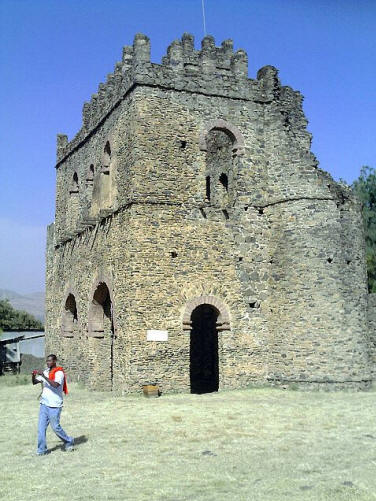
Gondar Ethiopia: King Fasil's Archive 1632-1667. This guy had a love affair
with books and had this library built to house his personal collection.
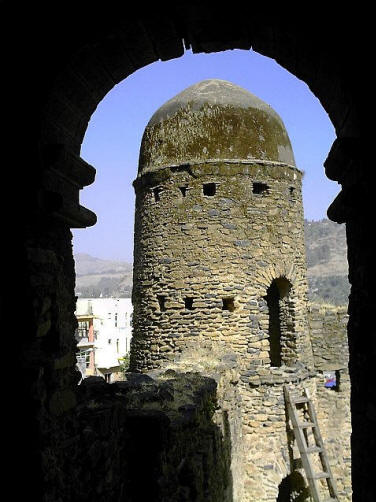
Gondar Ethiopia: Inside looking out of Messih-Seghed Bekaff's Castle
1721-1730
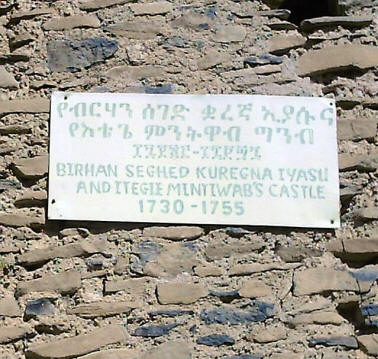
Gondar Ethiopia: Sign on Birhan Seghed Kuregna Iyasu and Itegie Mintiwab's
Castle 1730-1755
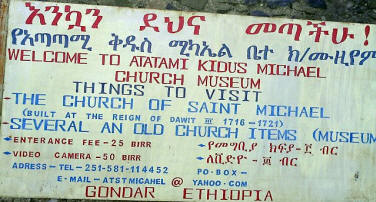
Gondar Ethiopia: This sign is the first thing visitors see when they exit
from the Royal Compound.
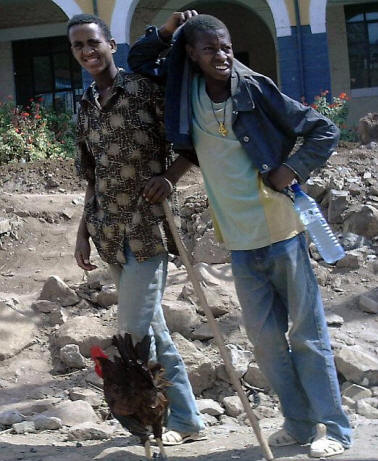
Gondar Ethiopia: A couple guys we passed on the road back to the hotel after
the city tour.

Gondar Ethiopia: People we passed on the road back to the hotel after the
city tour.
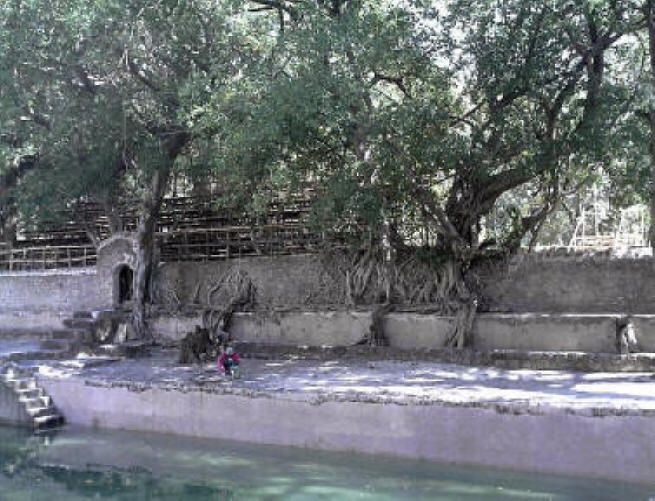
Gondar Ethiopia: Roots of trees around the wall at
Fasiladas Bath. They remind me of similar growths
seen at Angkor Wat in Cambodia. Notice the human
figure in the lower left quadrant.
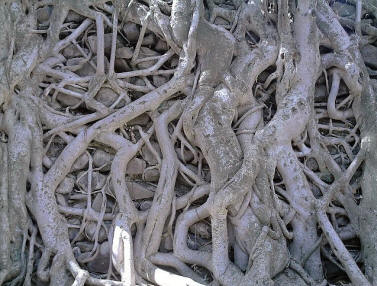
Gondar Ethiopia: Roots of trees around the wall at Fasiladas Bath. They
remind me of similar growths seen at Angkor Wat in Cambodia.
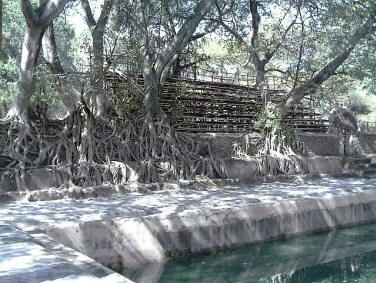
Gondar Ethiopia: Roots of trees around the wall at Fasiladas Bath. They
remind me of similar growths seen at Angkor Wat in Cambodia.

Gondar Ethiopia: Roots of trees around the wall at Fasiladas Bath. They
remind me of similar growths seen at Angkor Wat in Cambodia. |








































































































































